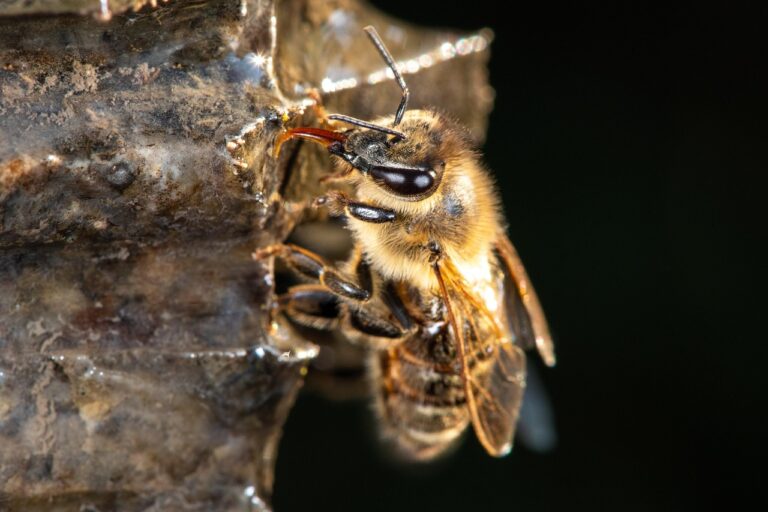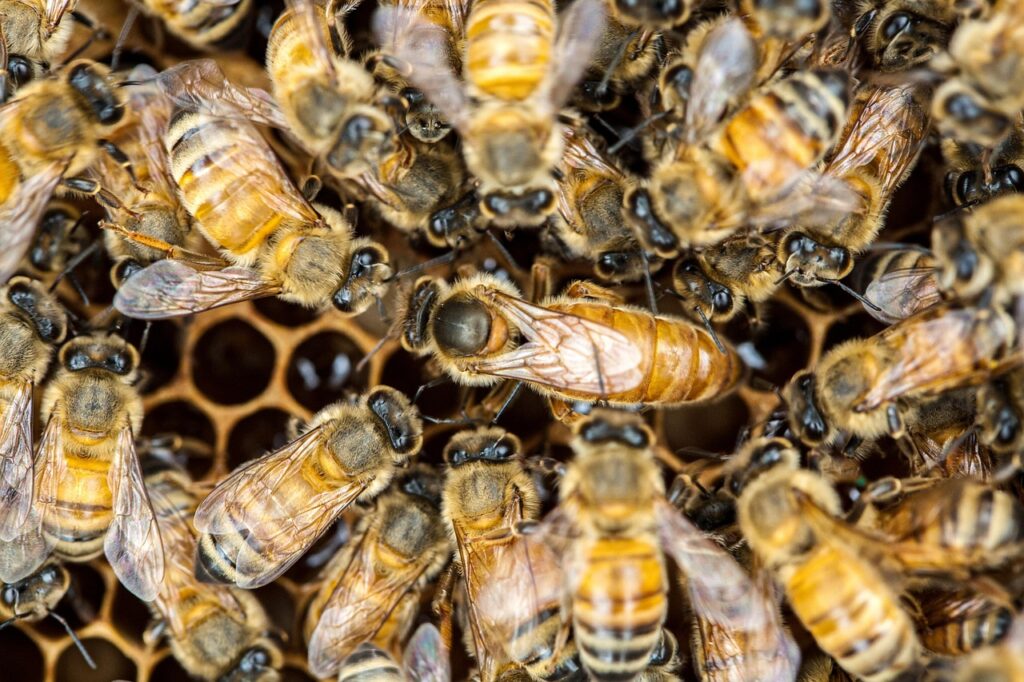Discover the Origin and Evolution of Bees: A Journey Through Deep Time
Bees represent one of the most remarkable evolutionary success stories on Earth, with their origins tracing back over 100 million years to the Cretaceous Period.
Their fossil record reveals a fascinating transition from carnivorous wasps to the diverse pollinating specialists we know today, fundamentally reshaping terrestrial ecosystems and co-evolving with flowering plants.
The Ancient Origins of Bees
Evolutionary Timeline and Ancestral Origins
The bee lineage emerged from predatory wasps approximately 120-130 million years ago during the Early Cretaceous Period[1][2][3].
This transformation from carnivorous hunters to pollen-feeding herbivores represents one of the most significant dietary transitions in evolutionary history[3][4].
Recent phylogenomic research has revealed that bees originated in western Gondwana, the ancient supercontinent that included present-day Africa and South America[2][5].
This finding challenges earlier assumptions about bee origins and demonstrates that bees were originally Southern Hemisphere insects that later colonized northern continents through complex patterns of dispersal and vicariance[2][6].
From Wasps to Bees: The Dietary Revolution
The transition from wasp to bee involved fundamental changes in feeding behavior and morphology. Ancestral sphecid wasps began incorporating pollen into their diet, initially as a supplementary protein source when prey was scarce[1]. Over time, this dietary shift became complete, with bees evolving specialized anatomical features for pollen collection and transport, including branched body hairs and modified leg structures[3][7].
The Fossil Record: Windows into Ancient Bee Life
Body Fossils in Amber
The oldest definitive bee fossil is Melittosphex burmensis, preserved in 100-million-year-old Burmese amber from Myanmar[8][7][9].
This remarkable specimen, measuring just 2.95 mm in length, exhibits a mosaic of wasp and bee characteristics, including narrow hind legs typical of wasps alongside branched hairs characteristic of modern bees[7].
Importantly, pollen grains were found associated with this fossil, providing direct evidence of early bee pollination activities[7].
Another significant discovery is Discoscapa apicula, also from 100-million-year-old Burmese amber, which represents the first primitive bee found with both pollen and beetle parasites – parasitic relationships that continue in modern bees[10][11].
This fossil provides unique insights into ancient ecological interactions.
The oldest definitive honey bee fossil is Trigona prisca, a stingless honey bee found in Cretaceous New Jersey amber dated to 74-96 million years ago[12][13].
This discovery was particularly significant because it represented highly derived social behavior preserved in the fossil record, indicating that complex bee societies had already evolved by this time[13].
Trace Fossils: Ancient Bee Architecture
Beyond body fossils, bee trace fossils – the preserved nests and burrows they constructed – provide crucial evidence of ancient bee behavior.
The oldest trace fossil evidence comes from 100-million-year-old bee burrows discovered in Patagonia, Argentina[14][15]. These fossilized nests consist of tunnels studded with grape-shaped alcoves where larvae developed, identical in architecture to nests built by modern sweat bees (Halictidae)[14].
These trace fossils are particularly valuable because they preserve behavioral evidence that body fossils cannot provide. The complex branching patterns and cell arrangements demonstrate that sophisticated nesting behaviors had evolved very early in bee evolutionary history[16][17].
The Challenges of Bee Fossilization
Bee fossils are relatively rare due to several factors. Most bee body fossils are preserved in amber, where insects became trapped in sticky tree resin that later fossilized[3][11].
Compression fossils – imprints left in sedimentary rocks – are less common but include wing impressions that can be identified by their distinctive vein patterns[18].
Bee nests and hives made of wax or other organic materials rarely fossilize, as these materials typically decompose before preservation can occur[19].
However, underground burrows and nests constructed in suitable sediments can be preserved as trace fossils, providing insights into ancient bee behavior and ecology[16][17].
Evolution of Bee Diversity and Social Behavior
Solitary vs. Social Bees: Different Evolutionary Paths
The vast majority of bee species (over 90%) are solitary, with females constructing and provisioning their own nests without assistance[20]. This represents the ancestral condition from which social behavior later evolved. Solitary bees include diverse groups such as mason bees, leafcutter bees, and many ground-nesting species[20].
The Origins of Eusociality
Social behavior in bees – characterized by cooperative brood care, reproductive division of labor, and overlapping generations – evolved multiple times independently. The most complex social systems evolved in the corbiculate bees (honey bees, stingless bees, bumble bees, and orchid bees)[21][22].
Fossil-calibrated molecular analyses indicate that eusociality first evolved at least 87 million years ago in the common ancestor of corbiculate bees, much earlier than previously estimated[21][22].
Advanced eusociality, featuring morphologically distinct queen and worker castes, evolved independently in honey bees and stingless bees from this primitively eusocial ancestor[21].
Honey Bee Evolution and Geographic Origins
Honey bees (genus Apis) have a more recent evolutionary history than bees as a whole.
The genus Apis appears in the fossil record around 34 million years ago at the Eocene-Oligocene boundary in European deposits[23].
However, living honey bee species have their center of origin in South and Southeast Asia, where all extant species except Apis mellifera (the Western honey bee) are native[23].
Interestingly, North America had its own native honey bee species – Apis nearctica – which lived approximately 14 million years ago during the Miocene epoch[24][25].
This species, known from a single fossil found in Nevada, went extinct long before human arrival in the Americas[25].
Reversals and Evolutionary Flexibility
Remarkably, the evolutionary trajectory toward sociality is not always irreversible. In some bee lineages, particularly halictid sweat bees, reversals from eusocial to solitary behavior have occurred multiple times – as many as 12 documented reversals in halictids alone[26][27].
This evolutionary flexibility demonstrates that social behavior can be gained and lost relatively easily in the early stages of social evolution[26].
Co-evolution with Flowering Plants
The evolution of bees is inextricably linked with the diversification of flowering plants (angiosperms). Bees and flowering plants began co-evolving around 120 million years ago, with each group driving diversification in the other[28][29].
Early bees likely pollinated primitive flowers that were small and simple, matching the small size of early bee fossils like Melittosphex burmensis[7].
Evidence from 99-million-year-old Burmese amber shows specialized beetle-flower interactions[29], and by the mid-Cretaceous, complex pollination relationships were well established.
Fossil flowers from this period show adaptations for specialized bee pollination, including complex structures for pollen presentation and nectar rewards[28][30].
Geological and Climatic Context
Bee evolution occurred during a period of dramatic geological and climatic change. The Early Cretaceous saw the breakup of the supercontinent Gondwana, which influenced bee biogeographic patterns[2].
The period was also characterized by warm global temperatures and high atmospheric CO₂ levels, creating favorable conditions for both flowering plant and bee diversification[28].
The rise of angiosperms during the Cretaceous provided new ecological opportunities for bees, leading to an “explosive diversification” that continued through the Cenozoic Era[2][5].
This co-evolutionary relationship between bees and flowering plants fundamentally transformed terrestrial ecosystems and established the pollination relationships that support modern biodiversity[28][31].
Modern Implications
Understanding bee evolutionary history has important implications for conservation and agriculture.
The fossil record demonstrates that bees have survived multiple mass extinction events and climate changes over their 120-million-year history, but also shows that individual species and lineages can go extinct, as evidenced by Apis nearctica and numerous fossil taxa that have no living relatives[25].
The deep evolutionary roots of bee-plant relationships highlight the critical importance of maintaining diverse pollinator communities for ecosystem stability.
The fossil record shows that specialized pollination relationships have deep historical roots, suggesting that disrupting these relationships could have far-reaching ecological consequences[28][31].
The remarkable diversity of bee fossils preserved in amber and sedimentary rocks continues to provide new insights into ancient ecosystems and evolutionary processes, demonstrating that the study of bee origins remains an active and evolving field of paleobiological research.
⁂
1. https://www.mannlakeltd.com/blog/how-have-honey-bees-evolved/
2. https://news.wsu.edu/press-release/2023/07/31/bees-likely-evolved-from-ancient-supercontinent-earlier-than-suspected/
3. https://www.museumoftheearth.org/bees/evolution-fossil-record
4. https://theholyhabibee.com/bee-ancestry/
5. https://entnem.ucdavis.edu/news/evolutionary-history-bees-time-and-space
6. https://pubmed.ncbi.nlm.nih.gov/37506702/
7. https://www.danforthlab.entomology.cornell.edu/wp-content/uploads/43poinardanforth2006.pdf
8. https://www.nbcnews.com/id/wbna15482996
9. https://pubmed.ncbi.nlm.nih.gov/17068254/
10. https://science.oregonstate.edu/IMPACT/2020/02/fossilized-insect-from-100-million-years-ago-is-oldest-record-of-primitive-bee-with-pollen
11. https://earthsky.org/earth/fossil-bee-trapped-amber-parasites-pollen/
12. https://www.pnas.org/doi/10.1073/pnas.85.17.6424
13. https://pmc.ncbi.nlm.nih.gov/articles/PMC281984/
14. https://www.nationalgeographic.com/science/article/oldest-ever-fossil-bee-nests-discovered-in-patagonia
15. https://igcat.org/oldest-evidence-of-modern-bees-found-in-argentina/
16. https://ri.conicet.gov.ar/bitstream/handle/11336/16865/CONICET_Digital_Nro.20808.pdf?sequence=1
17. https://www.nps.gov/subjects/fossils/trace-fossils.htm
18. https://askdruniverse.wsu.edu/2022/10/28/first-bee-made/
19. https://caterpickles.com/2012/11/19/can-bee-hives-be-preserved-as-fossils/
20. https://en.wikipedia.org/wiki/Bee
21. https://journals.plos.org/plosone/article?id=10.1371%2Fjournal.pone.0021086
22. https://pubmed.ncbi.nlm.nih.gov/21695157/
23. https://en.wikipedia.org/wiki/Honey_bee
24. https://nativebeeology.com/2018/01/26/native-honey-bees/
25. https://www.sciencenews.org/article/fossil-shows-first-all-american-honeybee
26. https://www.pnas.org/doi/10.1073/pnas.012387999
27. https://www.sciencedirect.com/science/article/pii/S0960982223007467
28. https://pmc.ncbi.nlm.nih.gov/articles/PMC3574388/
29. https://www.pnas.org/doi/10.1073/pnas.1916186116
30. https://www.pnas.org/doi/10.1073/pnas.0707989105
31. https://www.nature.com/articles/s41467-024-44784-4



